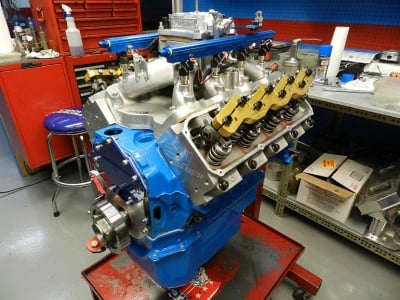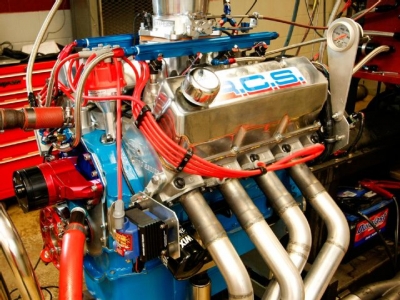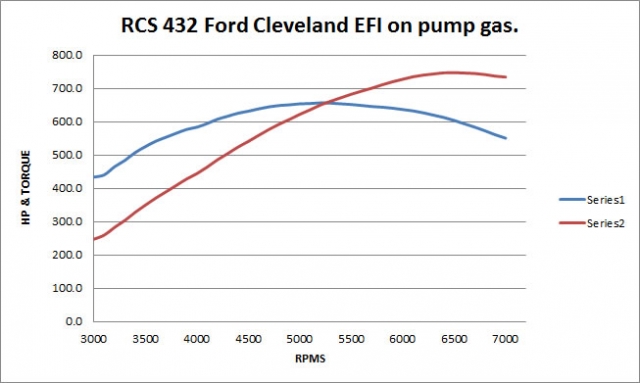The Amsoil Engine Masters Challenge is an annual engine-dyno competition promoted by Popular Hot Rodding magazine to showcase unique and powerful engines on the market today. Ron Stanislawczyk and his team at RCS Racing Engines in Pittsburgh have more than 30 years of engine building experience, and assembled a 432ci Ford Cleveland-based engine for this year’s EMC event.
“Our first thought was to build a LS7, as we expected so many others would follow the LS trend. While my eyes focused on the Modular engines and like others, we were concerned that top-end power would be low,” Stanislawczyk tells Engine Labs. “The CHI-head Cleveland was attractive based on the rules, but the block was a big concern from the BS on the web about OEM Cleveland blocks.”
After overcoming his initial reservations, the team forged ahead to build the Cleveland/CHI 3V cylinder head combination as he felt it would make more power per cubic inch than the LS designs. A number of stumbling blocks, including shipping time on parts, put them behind the 8-ball, but once the products (heads and manifold) were in hand, it was time to get started on the build.
The intake and exhaust ports of one cylinder were ported by hand until they settled on a proven design, then the port design was digitized to run on the rest of the heads, and finally finished by hand to get them within one-half of one percent on the flow bench, for final flow numbers of 300cfm at .400-inch lift, 350 cfm at .500-inch, 380 cfm at .600-inch and 400cfm by .800-inch lift.
Noted during the engine building process were some issues with the intake manifold, namely the runner angle into the cylinder head.
“It is very difficult for high velocity air entering the plenum to turn into the runners when the angle into the runner is more than 30 degrees,” says Stanislawczyk. “Even though the individual flow rates of the manifold and head combined were 380 cfm, we knew this much air per cylinder would never make it through the turn of the manifold and would hurt our expected top end power of 770 to 780 horsepower.”
The engine itself is based around an early Cobra Jet 4-bolt main block that was sourced in Canada and ended up needing three sleeves during the machining process, due to rust pits in the cylinder walls from 45 years of being tucked away in a garage. Final bore size finished up at 4.021-inch with a 4.25-inch stroke to make the aforementioned 432 cubes.
 The CHI cylinder head and intake manifold combination topped off the works, fed by an Aeroflow 1,375cfm throttle body. Other engine components are not disclosed due to the nature of the competition, but if you’re willing to buy the engine, which is for sale on the RCS Racing Engines website, Stanislawczyk will be happy to share the details of its construction with you.
The CHI cylinder head and intake manifold combination topped off the works, fed by an Aeroflow 1,375cfm throttle body. Other engine components are not disclosed due to the nature of the competition, but if you’re willing to buy the engine, which is for sale on the RCS Racing Engines website, Stanislawczyk will be happy to share the details of its construction with you.
The team had a number of struggles on the RCS dyno in the days leading up to the EMC event. Ultimately a pair of equipment failures had them heading to the event blind in terms of low-rpm performance. An issue with the engine management system caused problems with tuning, while the shop’s dyno lost the internal seal on the power absorber and they couldn’t solidify the low-speed tuning until they got the engine on the dyno at the event.
The engine was broken in with a carburetor and subsequently switched over to fuel injection, but the fuel injection system ultimately had issues with the signal from the cam-pulse distributor. Instead of being able to run the engine on sequential fuel injection that follows the engine’s firing order, they had to tune the engine with timed sequential fuel injection. The datalogger in the ECU also presented some issues, forcing them to tune the engine the old-school way.
Never a team to quit, they soldiered on through the problems and in the long run were able to salvage the project for the EMC and turn in an outstanding 750 horsepower and 660 foot-pounds of torque, which was all-in by 6,500 rpm.
Remember, this is a pump gas engine, and would make an excellent candidate for any street rod or cruiser looking for killer naturally-aspirated power.



















